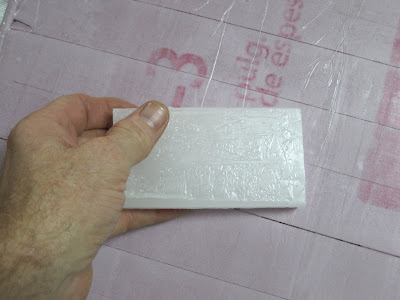

There. That's better.
 I have been working on a number of different things at the same time trying to keep the project moving. Some things must be completely fitted before another related item can be properly sized. For instance I need to be sure that the brake disc is positioned so that the caliper can be accessed by a control cable. I need supports for the front roll bar landings that will work in with the contours of the body. So the following are a few miscellaneous things that I am doing so we can get serious about finishing this cart.
I have been working on a number of different things at the same time trying to keep the project moving. Some things must be completely fitted before another related item can be properly sized. For instance I need to be sure that the brake disc is positioned so that the caliper can be accessed by a control cable. I need supports for the front roll bar landings that will work in with the contours of the body. So the following are a few miscellaneous things that I am doing so we can get serious about finishing this cart. I needed to get an idea of how the chain was going to fit and work with the chain tensioner. In case you have not worked with roller chain before I wanted to show a procedure for breaking the chain and reassembling it. They make some fancy tools to make this easier but the method I use is really not that difficult. I am sure there are better ways to do this but this works for me. First of all you need to determine how long the chain needs to be. The easiest way to do this is to test fit it to the sprockets. You want to start out with as much adjustment as possible so that you don't run out of room to adjust the chain before the chain wears out. My experience with chain dates back to the 70's when I had a little Yamaha street bike. My son Cory tells me that chains are much better today than they were back then.
Once you have determined how long the chain needs to be you will need to break it. It is not so much breaking it as grinding it. If you are careful you can actually use the bench grinder to grind off the outside of the posts of the link.

Once the end is ground off then you can use a metal punch that is slightly smaller than the diameter of the post and drive the post out of the link. This actually takes more force than you might think. I like to drive it against the wood of the top of the work bench because it allows the opposite end of the post to sink into the softer wood as it is driven out. It will most likely not budge for several strikes. You can see that it is starting to move in the next Photo. I probably hit it with half a dozen solid blows before it started moving.

Next you can lightly clamp the chain in the vise and finish driving through the leg if need be. Then just repeat the procedure on the other leg of the link.

The link can now be completely removed from the chain.
 The chain can now be reassembled using a master link.
The chain can now be reassembled using a master link. 
I have also been working on the test fiberglass hood. I am just experimenting with some different ideas of how to contour the body panels. The surface of the foam mold has to be properly treated before the fiberglass is applied in order to be sure the fiberglass does not stick to the mold. First of all the mold needs to be completely covered with plastic boxing tape. And I mean completely covered because I left a very small strip uncovered and it stuck to the mold very aggressively.

I am leaving one edge untapered to see if that works better.

The last step is to wax the surface as an added deterrent to sticking. I just used a bar of paraffin to scrape on the surface.













No comments:
Post a Comment